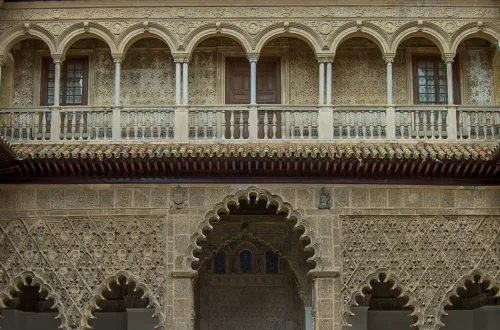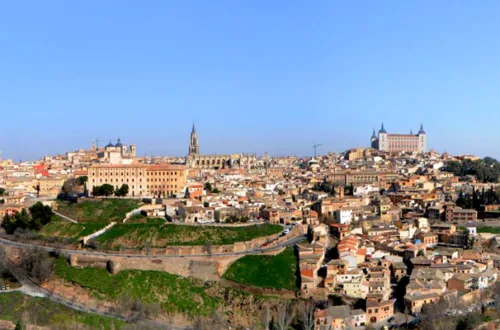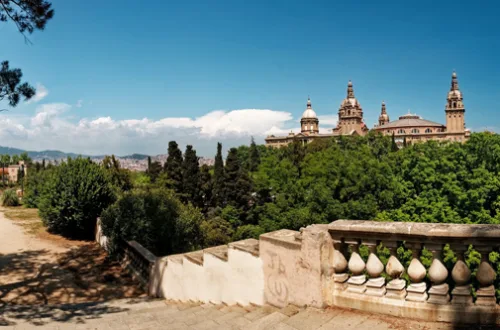
The Outstanding Seville Cathedral Visit: Discovering the Hidden Treasures Within
As you step into the sun-drenched streets of Seville, the city’s heartbeat guides you to an architectural marvel that towers over its skyline – the Seville Cathedral. This isn’t just a visit; it’s a pilgrimage to the soul of Andalusian culture and history. Each stone and stained-glass window tells a story, echoing through the ages. A testament to faith and artistry, the cathedral stands as a historical and cultural icon of Spain, inviting wanderers from across the globe to bask in its magnificence.
Declared a UNESCO World Heritage Site, the Seville Cathedral captures the essence of a bygone era, preserved within its imposing walls and sprawling courtyards. A Seville Cathedral visit is more than a mere tour; it’s an immersive journey through time, where every corner holds a hidden treasure waiting to be discovered. From the moment you cross its threshold, you are no longer just a visitor—you are part of the cathedral’s continuing history, a tale as enduring as the structure itself.
- Weaving Through the Historical Tapestry of Seville Cathedral
- Artistic Wonders of the Cathedral
- The Cultural Heartbeat of Seville
- The Giralda Bell Tower – A View from Above During Your Seville Cathedral Visit
- Royal Chambers and Hidden Halls – The Secrets Within Your Seville Cathedral Visit
- Planning Your Visit – Navigating the Grandeur of Seville Cathedral
- The Cathedral's Place in Modern Spain – A Testament to Time During Your Seville Cathedral Visit
- The Enriching Embrace of Seville Cathedral
Weaving Through the Historical Tapestry of Seville Cathedral
Embarking on a Seville Cathedral visit is akin to traversing the annals of time, where each stone is a syllable in the chronicle of its grand design. The origins of this monumental edifice date back to the early 15th century, a period that saw the burgeoning of Gothic architecture across Europe. It was conceived in the fervor of conquest, on the very site where the Almohad Mosque once stood, symbolizing a seismic shift in cultural paradigms.
The construction of Seville Cathedral, officially known as the Cathedral of Saint Mary of the See, commenced in 1401. The intent was not merely to create a place of worship, but to construct a temple so opulent and grand that future generations would regard it with awe. Over a century of meticulous craftsmanship followed, with generations of stonemasons, carpenters, and artists pouring their skill into what would become the largest Gothic cathedral in the world.
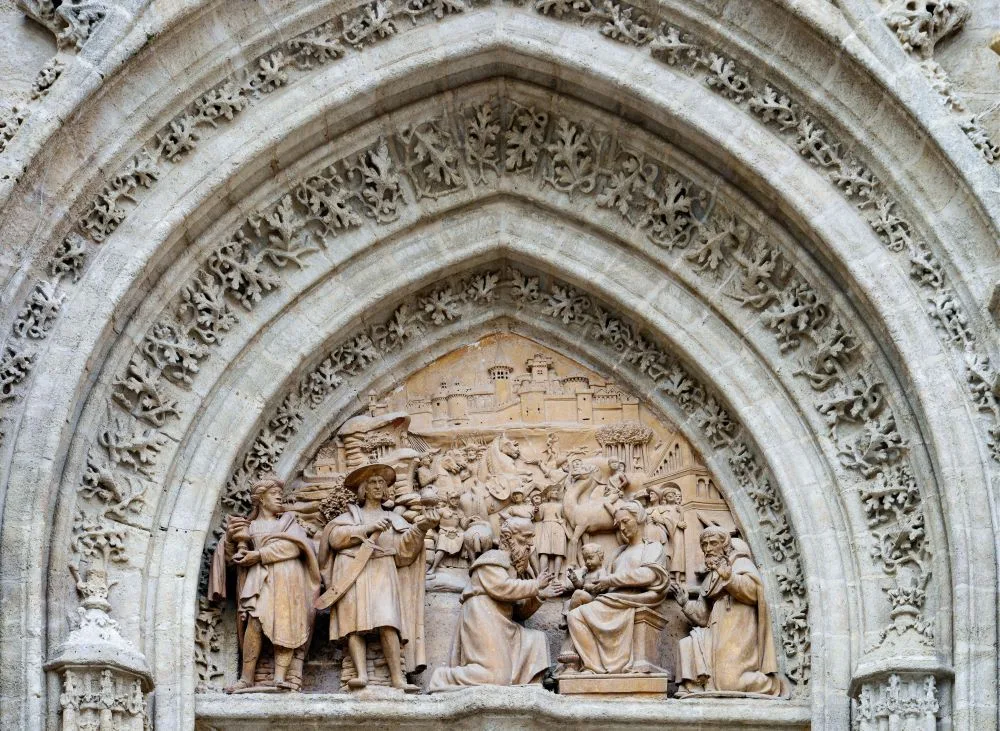
A Chronicle of Construction
As you wander through its vast nave and ambulatory during your visit to Seville Cathedral, imagine the countless artisans laboring under the Andalusian sun, hoisting stones and carving intricate facades. The completion of the main body in 1506 was not an end, but a prelude to continuous enhancements that would span centuries. Each chapel, each altar, and each ornamentation added to the cathedral’s narrative, enriching the historical tapestry that visitors unravel with every step through this sacred space.
In your journey through Seville Cathedral, you are not merely a spectator of history; you are retracing the paths of kings who sought divine favor, of pilgrims who sought solace in its sanctuaries, and of a city that rose to prominence through its hallowed halls. The chronicle of its construction is a testament to human endeavor and faith—a story best appreciated as you stand beneath its soaring vaults and bask in the silent eloquence of its stones.
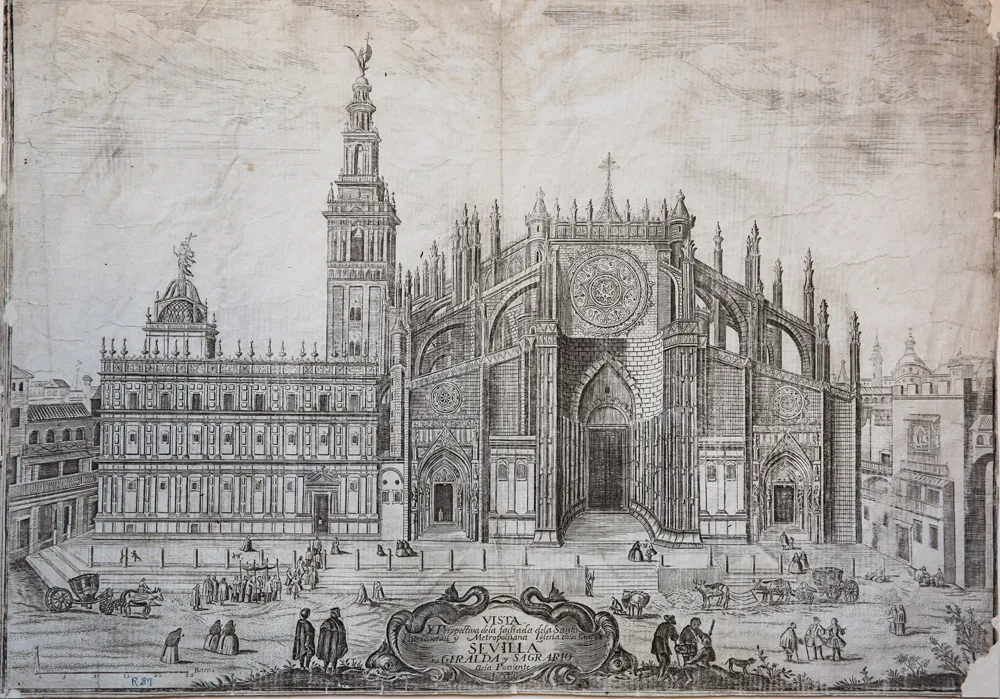
Architectural Evolution – A Symphony of Styles
A Seville Cathedral visit is not just a step back in time; it’s a journey through the evolution of architectural beauty. As you meander through this hallowed sanctuary, you witness a symphony of styles harmoniously intertwined. The Gothic foundations of the cathedral set the stage for what is a breathtaking confluence of artistic expressions, where the austerity of medieval engineering meets the opulence of the Baroque and the measured grace of the Renaissance.
The Gothic elements are the most prominent, with ribbed vaults soaring skywards, pointing heavenward as if in silent praise. These towering structures are supported by flying buttresses, a hallmark of Gothic ingenuity, allowing the walls to be pierced by a constellation of stained-glass windows that bathe the interior in celestial light during your visit to Seville Cathedral.
As time marched on, the cathedral became a canvas for subsequent generations, each eager to leave their mark in stone and mortar. The Baroque flair is evident in the lavish altarpieces that adorn the chapels, their gilded surfaces capturing the flicker of candlelight and reflecting an era’s affinity for grandeur. The intricate carvings and dramatic statuary are a testament to the Baroque’s emotive power, designed to evoke awe and wonder on your pilgrimage through its naves.
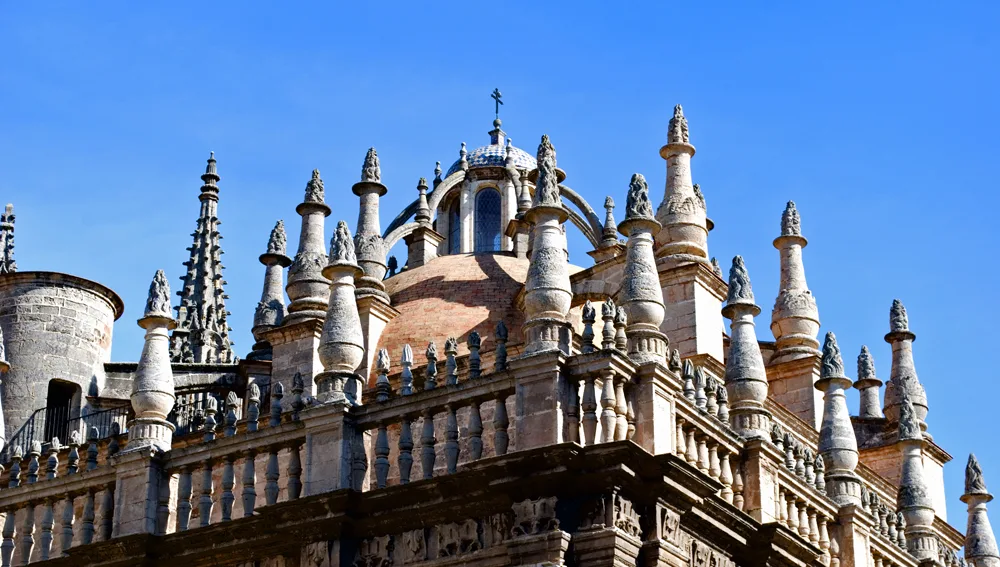
Puerta del Perdón: a highlight of the Seville Cathedral visit
Amidst this splendor, the Renaissance makes its presence felt with measured restraint. The serene Puerta del Perdón, with its classical columns and pediment, offers a counterpoint to the Gothic spires that dominate the skyline. The Door of the Conception, another Renaissance masterpiece, stands as an ode to symmetry and proportion, inviting introspection amidst the cathedral’s grand narrative.
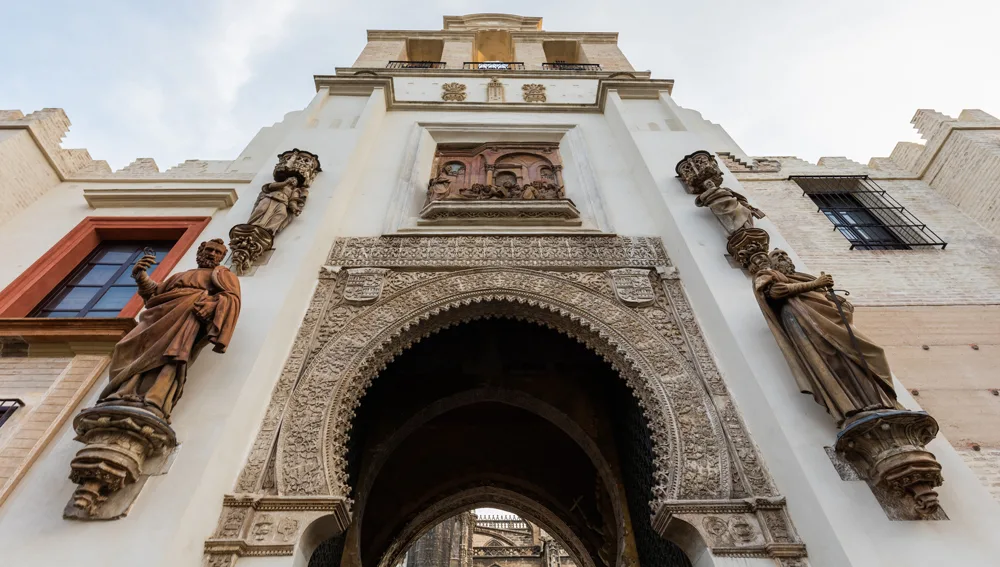
Each architectural layer of Seville Cathedral, from its Gothic roots to its Baroque crescendos and Renaissance flourishes, tells a story of a city and its people—artists, architects, and patrons who aspired toward the divine. A Seville Cathedral visit is thus an encounter with an ever-evolving masterpiece, a place where art and history are etched into every stone and where each style speaks to the visitor in a timeless dialogue of beauty.
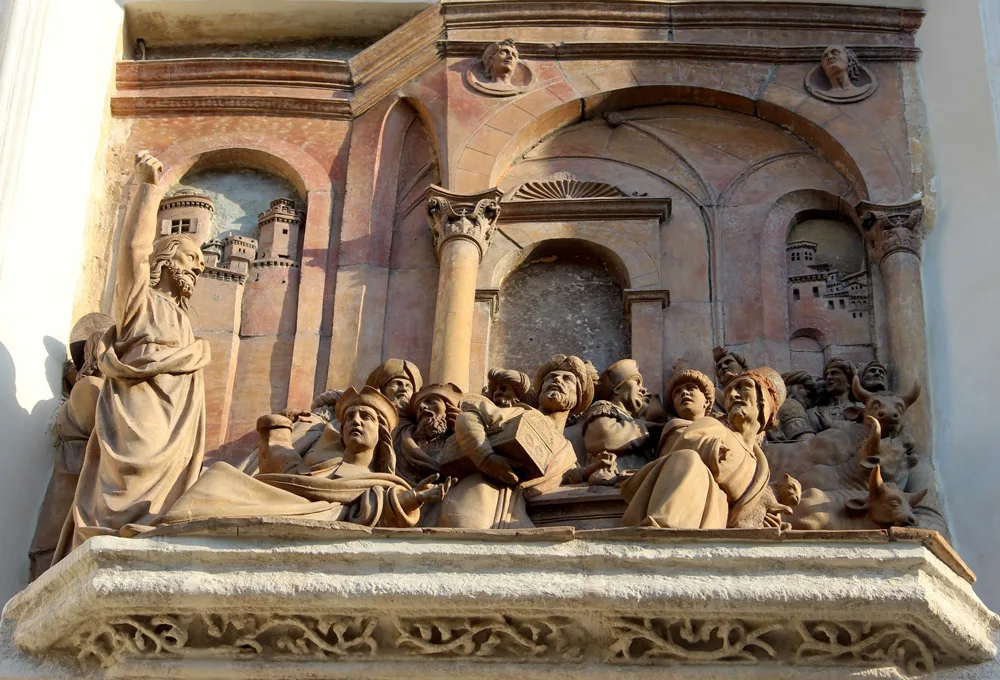
Artistic Wonders of the Cathedral
A Seville Cathedral visit is incomplete without immersing oneself in the artistic ocean that resides within its walls. It is here that art transcends mere decoration and becomes a divine narrative, each piece a sermon etched in color and form.
The main altarpiece, a staggering masterpiece of Gothic woodcarving, rises from the floor to the vaults, a vertical journey of biblical tales meticulously captured in wood and gold leaf.
This retablo mayor is considered the magnum opus of Pierre Dancart and his successors, a project that spanned over 80 years, culminating in an awe-inspiring tableau of Christian iconography. As you stand before it during your visit to Seville Cathedral, you can’t help but be drawn into the stories it tells. The life of Christ, the passion, and the glory, each panel a chapter from the scriptures brought to life through sublime craftsmanship.
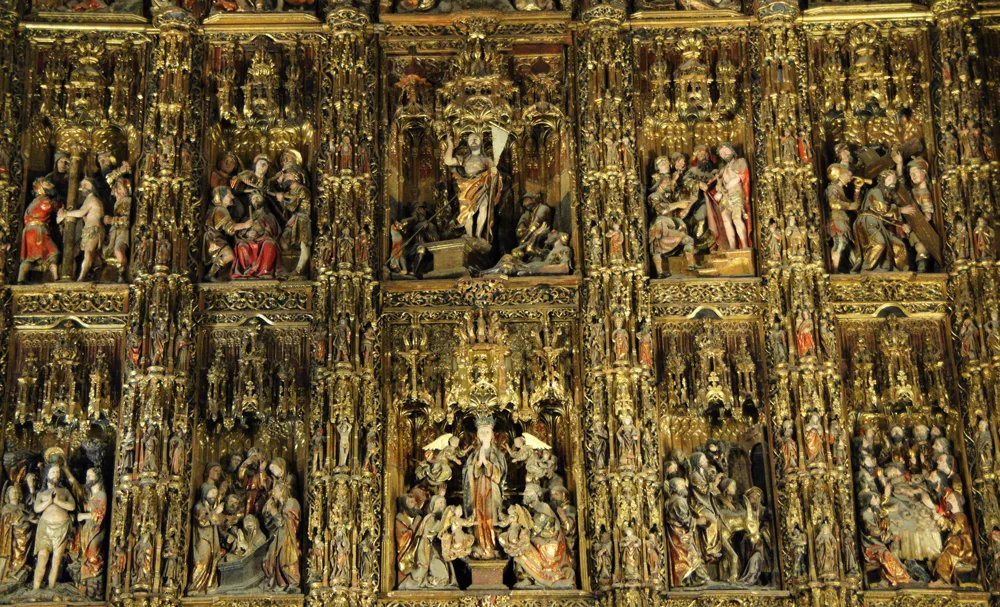
Masterpieces to discover during the Seville Cathedral visit
Flanking the nave and aisles, an array of chapels’ houses further treasures. Notable paintings by some of the Spanish Golden Age’s most revered artists, such as Murillo, Zurbarán, and Goya, adorn the walls. These works offer a glimpse into the spiritual and cultural zeitgeist of their times, with each canvas and fresco inviting contemplation and admiration.
The art of Seville Cathedral is not confined to its altarpieces and paintings alone. Sculptures carved from marble and wood stand sentinel throughout the cathedral, their expressions capturing the human encounter with the divine. The sacristies and treasury are a trove of religious artifacts, where reliquaries, vestments, and liturgical items tell of a faith expressed not just in prayers but also in the beauty of sacred objects.
During your Seville Cathedral visit, allow yourself to be captivated by these artistic wonders. Each work not only embellishes this house of worship, but also serves as a conduit between the earthly and the ethereal, between the faithful and the infinite. Here, art is not simply seen; it is experienced—a testament to the cathedral’s enduring legacy as a sanctuary of spirituality and a gallery of heavenly art.
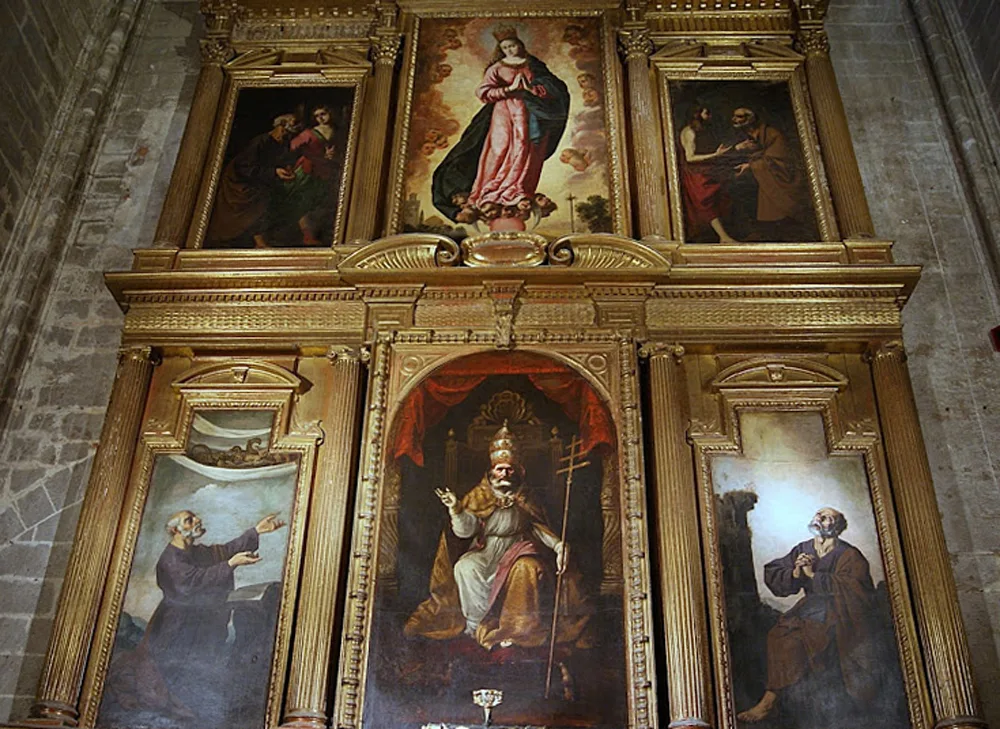
Stained Glass Splendor – Illuminated Tales During Your Seville Cathedral Visit
As you step into the hallowed space during your Seville Cathedral visit, the dance of light through stained-glass windows bathes you in a kaleidoscope of colors, each pane a vibrant shard of history. The cathedral’s stained-glass is not merely a decorative element; it is a storytelling medium, a biblical manuscript illuminated by the Andalusian sun.
Crafted by master glaziers, these windows are a testament to the Gothic era’s love affair with light and color. From the moment construction began in the early 15th century, a narrative was set in glass, intended to educate and inspire awe. Over the centuries, these windows have become a visual symphony, recounting tales from the creation to the last judgement, encapsulating saints’ lives, and Christ’s passion and resurrection.
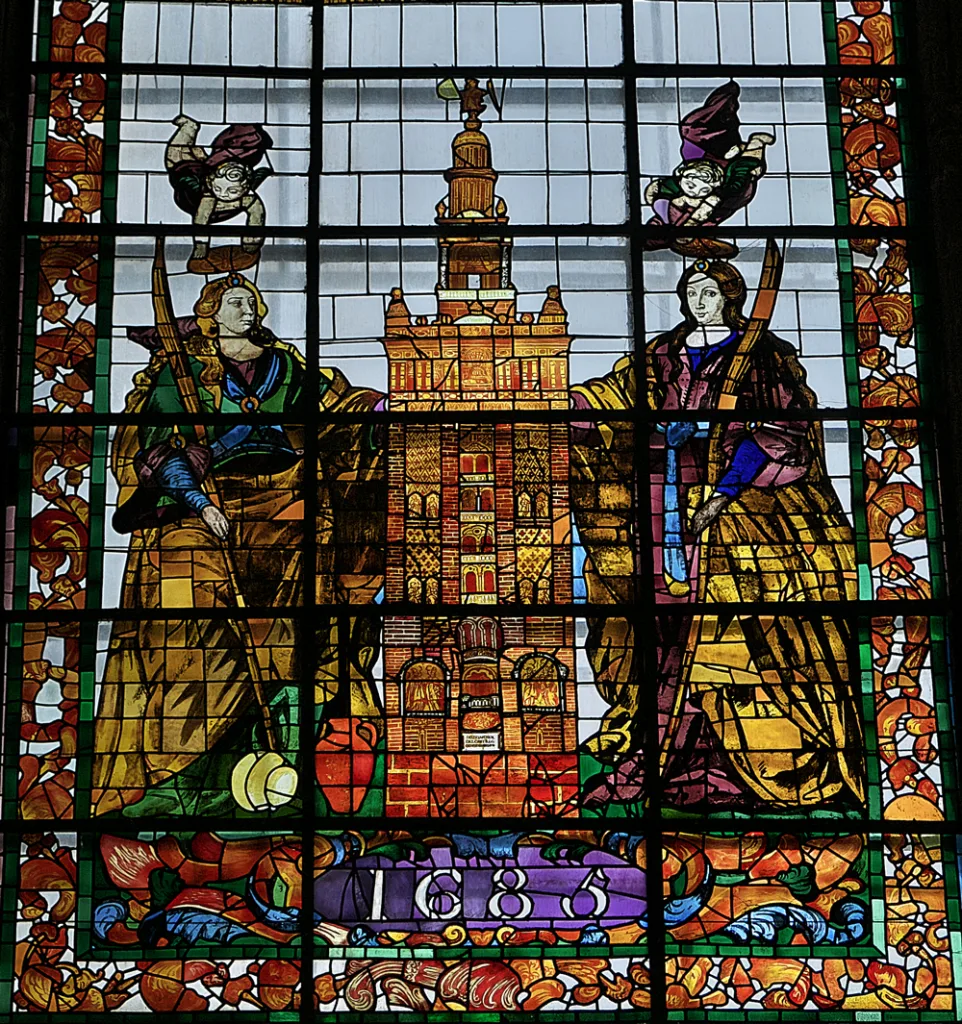
Special moments during the Seville Cathedral Visit
During your visit to Seville Cathedral, take a moment to stand beneath the Rose Window on the western façade, a masterpiece of geometry and hue that captures the essence of divine perfection. Or wander to the Capilla Mayor, where the windows reach their narrative and artistic zenith, casting their stories onto the stone and marble below.
Each window in Seville Cathedral serves as a vessel for storytelling, with light as its narrator. The Old Testament prophets, apostles of the New Testament, and scenes from Christ’s life are not just depicted; they are animated by the shifting sun, changing with the hours, offering a different perspective with each visit.
A Seville Cathedral visit offers a unique opportunity to experience these stained-glass narratives as they were meant to be seen: in silent contemplation, with rays of light transcending glass to touch the soul. This is the splendor of Seville Cathedral’s stained-glass—a timeless splendor that has been enchanting visitors for centuries and continues to be a pivotal experience of any visit to this architectural wonder.
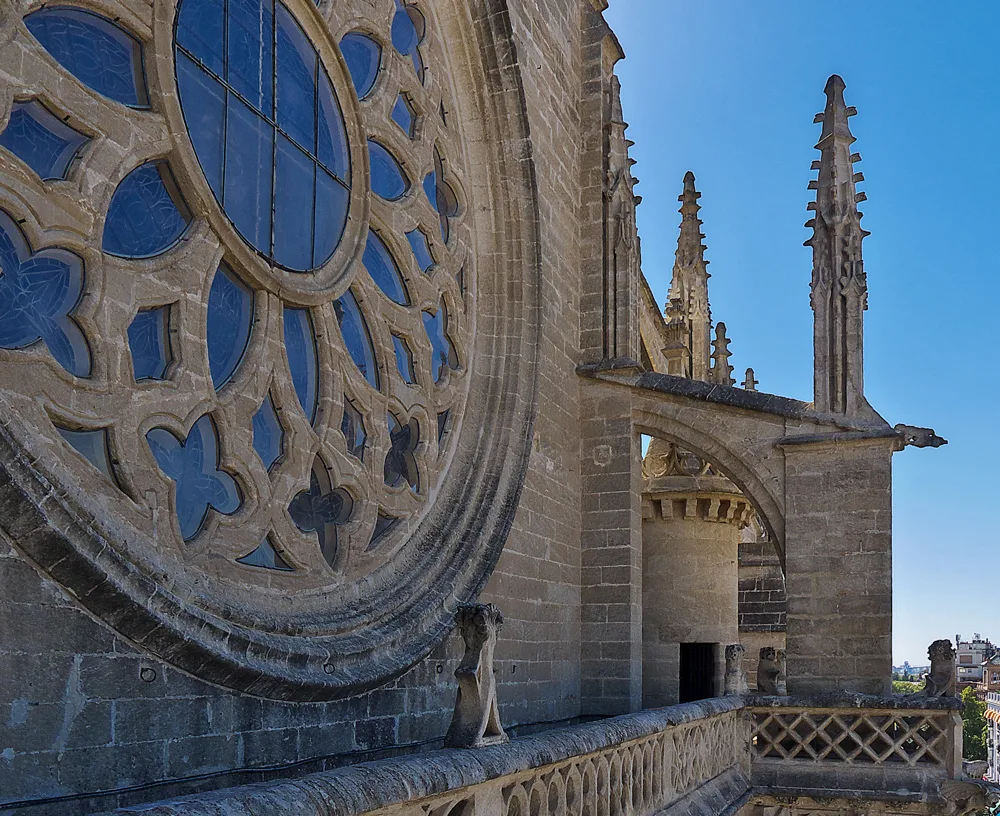
The Cultural Heartbeat of Seville
Embarking on a Seville Cathedral visit offers more than a walk through a monumental landmark; it is an encounter with the vibrant cultural essence of Seville itself. This cathedral, the largest Gothic structure of its kind and a UNESCO World Heritage Site, does not merely rest in the heart of the city. It beats in unison with it, orchestrating a rhythm that resonates through the narrow cobblestone streets and across the sun-drenched plazas.
The following sections delve into the rich cultural tapestry woven within this architectural marvel, revealing how music and festivity converge to make the cathedral a living testament to Seville’s historical grandeur and contemporary vibrancy.
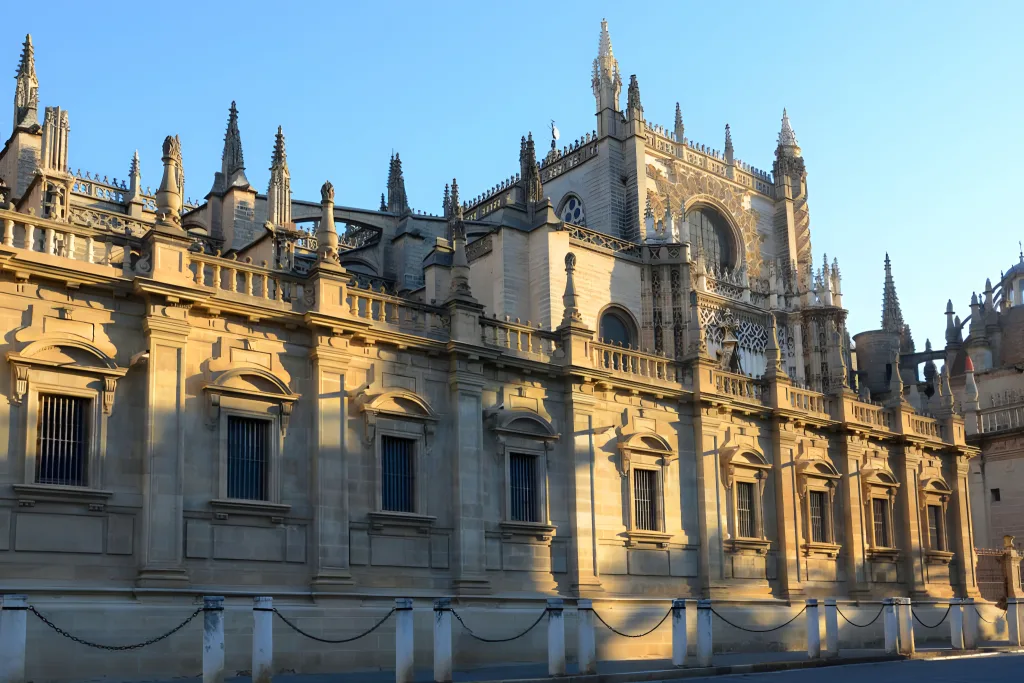
Harmonies of Devotion – Music and Choir in the Seville Cathedral
A Seville Cathedral visit resounds with more than the echoes of history; it vibrates with the living pulse of music. Within these ancient walls, the cathedral’s choir and music have been a cornerstone of daily services and grand celebrations for centuries. The Cathedral’s choir, one of the oldest in the world, is a blend of angelic voices that rise in a crescendo, harmonizing with the grand organ to fill every corner of the sacred space.
As you explore the cathedral, you may encounter the ethereal sounds of rehearsal, a preview of the liturgical and classical compositions that are performed during Mass and vespers. Each note played on the historic organs and sung by the choir during your visit to Seville Cathedral is a thread in the cultural tapestry of Seville, a living tradition that has been passed down through generations.
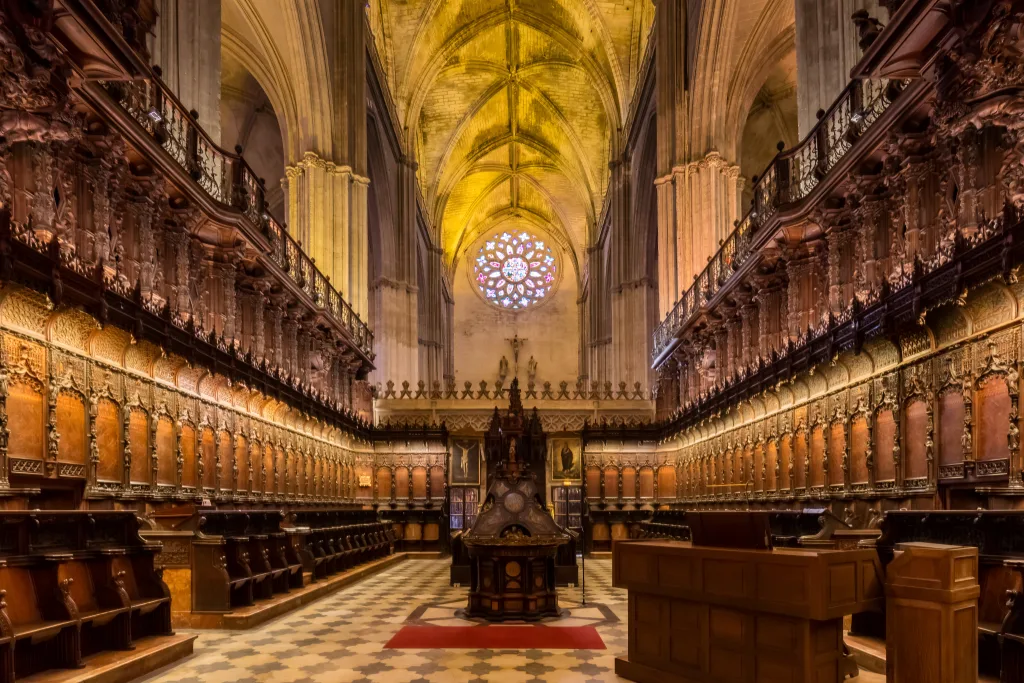
A Tapestry of Traditions – Festivals and Celebrations
The cathedral is not only Seville’s religious nexus but also the heart of its cultural festivities. A Seville Cathedral visit during one of the many festivals will reveal a spectacle where faith and local culture intertwine in a vibrant display. Semana Santa (Holy Week) and Feria de Abril (April Fair) stand out as events where the cathedral becomes a focal point for processions and celebrations that spill out into the streets.
During these festivals, the cathedral’s grandeur is complemented by the colorful parades, intricate floats, and the solemn beauty of pasos (religious statues) that are carried through Seville’s labyrinthine alleys. The air is rich with the scent of incense and the sound of marching bands, creating a sensory experience that is as moving as it is memorable.
Your Seville Cathedral visit during these times offers a unique insight into the soul of the city. It’s a chance to witness firsthand how this magnificent edifice is not just a static monument but a dynamic participant in Seville’s living history. It embraces and enhances each celebration with its presence and proves that it remains, as ever, the cultural heartbeat of Seville.

The Giralda Bell Tower – A View from Above During Your Seville Cathedral Visit
A pinnacle of architectural wonder awaits those who embark on a Seville Cathedral visit. The Giralda Bell Tower, a resplendent minaret turned bell tower, stands as a sentinel over Seville, offering panoramic views that promise to be the zenith of any visit. This former minaret of the Almohad mosque, which the cathedral grandly succeeded, tells a tale of Seville’s layered history—a palimpsest of Islamic artistry and Christian conquest.
As you ascend the ramps designed centuries ago to accommodate those on horseback, each step takes you further into the narrative of the past, until you emerge above the cityscape. Here, during your visit to Seville Cathedral, you are treated to a breathtaking vista that spans the charming old town, the meandering Guadalquivir River, and the vibrant rooftops stretching toward the horizon.
The Giralda offers more than a visual feast; it is a historical journey that culminates in a communion with the city itself. From its vantage point, each tolling of the ancient bells marks the passing of time in a city that is as timeless as it is dynamic. To stand within the belfry and gaze out is to understand the true spirit of Seville—a spirit that has watched over this city for centuries and continues to enchant every visitor who climbs the tower to touch the sky.
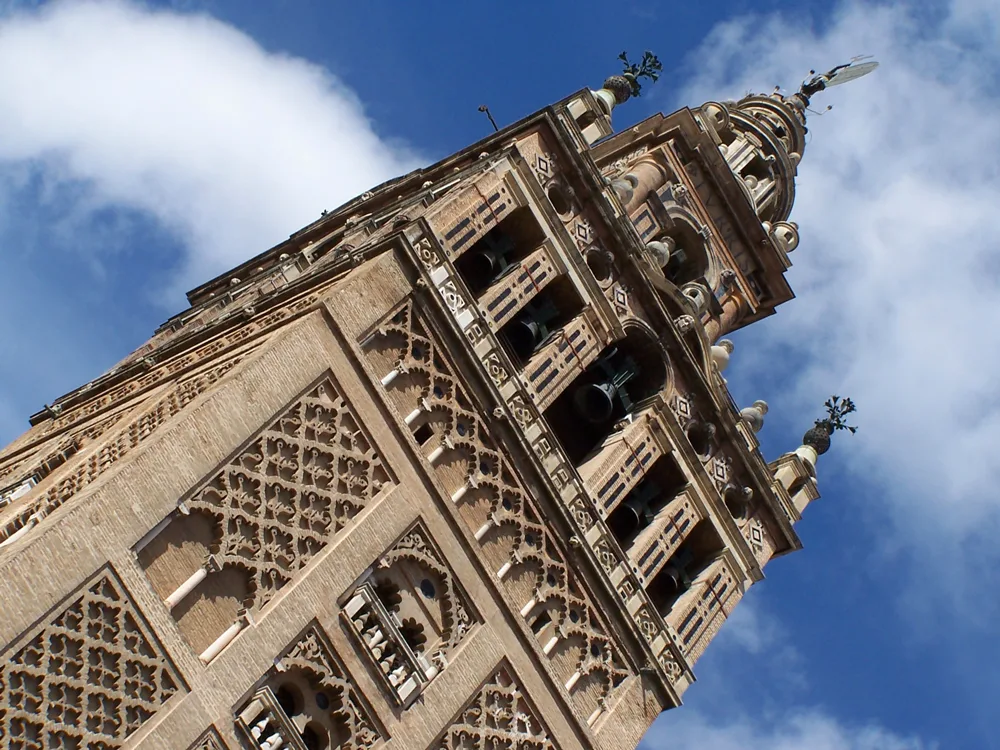
Royal Chambers and Hidden Halls – The Secrets Within Your Seville Cathedral Visit
The grandeur of Seville Cathedral extends beyond its soaring naves and altars; it whispers through secluded corridors and behind closed doors. A Seville Cathedral visit is incomplete without venturing into the royal chambers and hidden halls, each echoing with the silent footsteps of history.
These lesser-known parts of the cathedral hold stories untold to the casual observer. Here, during your visit to Seville Cathedral, you can trace the contours of private devotion and regal legacy. The royal chambers, once reserved for kings and queens, offer an intimate glimpse into the spiritual lives of Spain’s monarchs. With opulent yet solemn decor, these rooms reflect the weight of the crown and the human desire for divine favor.
As you meander through the hidden halls, you encounter the breath of centuries past. These corridors have seen processions of clerics and nobility, the quiet intrigue of ecclesiastical politics, and the silent prayers of those seeking solace within their cool embrace. Each hall, with its vaulted ceilings and hushed atmosphere, invites a moment of reflection on the countless souls who have sought refuge in their seclusion.
The history within these spaces is palpable, almost tangible, as if waiting to be rediscovered by those who wander through. To explore these royal chambers and hidden halls during your Seville Cathedral visit is to connect with a lineage of sacred tradition, to walk in the shadows of history’s pageantry, and to uncover the quiet heartbeat of this majestic cathedral.

Planning Your Visit – Navigating the Grandeur of Seville Cathedral
Embarking on a Seville Cathedral visit requires a touch of planning to ensure a seamless experience amidst its grandeur. To fully appreciate the world’s largest Gothic cathedral, it’s wise to consider purchasing tickets in advance, thus avoiding the lengthy queues that often snake around its imposing façade.
Timing is crucial; visiting early in the morning or later in the afternoon can help you avoid the peak crowds that flock to this historic site. Moreover, a mid-week visit to Seville Cathedral can afford a more tranquil atmosphere, allowing you to absorb the splendor with fewer distractions.
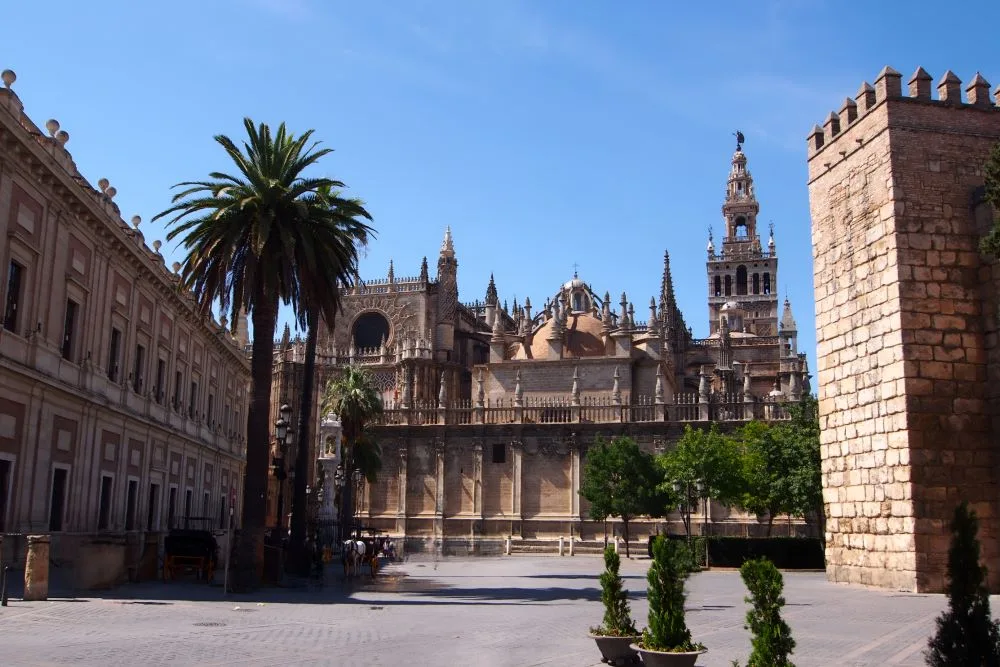
Tips and Etiquette – Embracing the Sacred During Your Seville Cathedral Visit
As with any place of worship, there are customs and courtesies to observe during your Seville Cathedral visit. Dressing modestly is a sign of respect; shoulders and knees should be covered as you wander through this sacred space. Photography is allowed, but it’s best to do so without flash to preserve the integrity of the centuries-old art and to maintain a respectful ambiance.
To truly enrich your experience, consider engaging with an official guide or an audio guide available at the entrance. These resources can offer profound insights into the cathedral’s history and art, enhancing your appreciation of this architectural masterpiece.
Lastly, while the allure of the main attractions is undeniable, allow yourself time to simply be in the space. Sit in a quiet corner, reflect on the sheer beauty, and let the essence of this historic sanctuary wash over you. Your Seville Cathedral visit is not just a tour; it’s an opportunity to connect with centuries of spirituality and tradition.
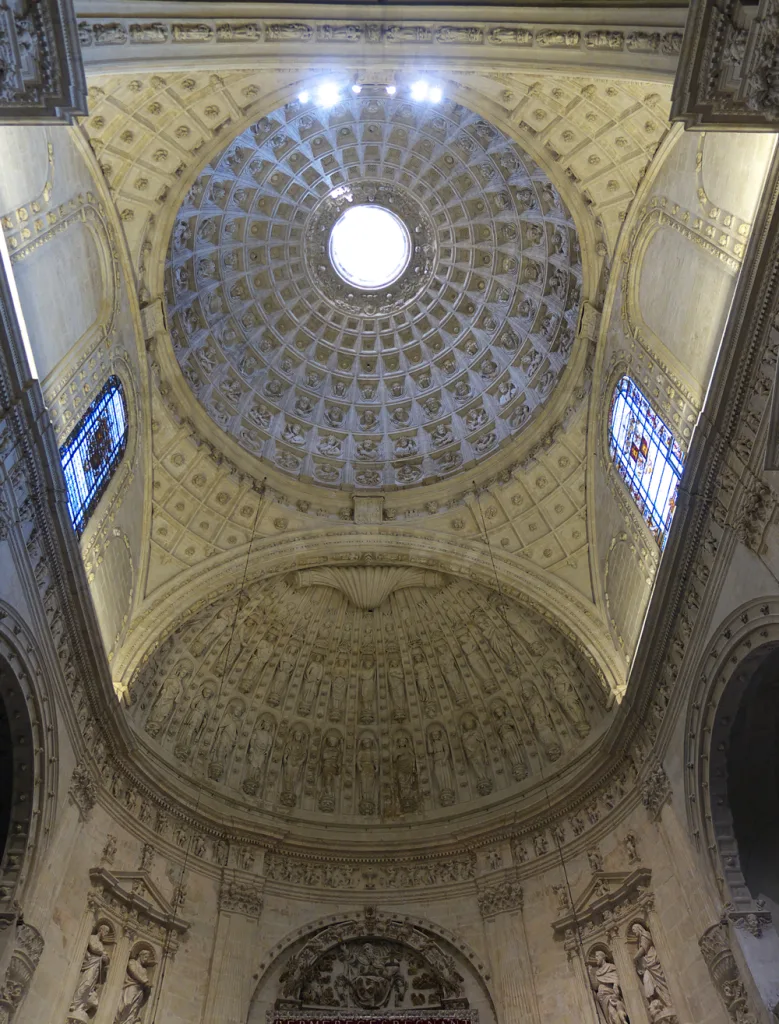
The Cathedral’s Place in Modern Spain – A Testament to Time During Your Seville Cathedral Visit
In contemporary Spanish culture and society, Seville Cathedral stands as a testament not only to the past but also to the enduring spirit of Spain. It remains a cornerstone of community life, a place where traditions are honored and where modern narratives are woven into the historical fabric. The cathedral’s role extends beyond religion; it is a cultural icon, a gathering place for celebrations, and a symbol of the city’s resilience and beauty.
As you conclude your Seville Cathedral visit, it becomes clear that this structure is more than stone and mortar; it is a living part of Spain’s soul. It resonates with the voices of today just as it has with those of the past. In the bustling streets that surround it, amidst the laughter of children and the chatter of daily commerce, Seville Cathedral continues to reflect the vibrant, ever-evolving story of modern Spain.
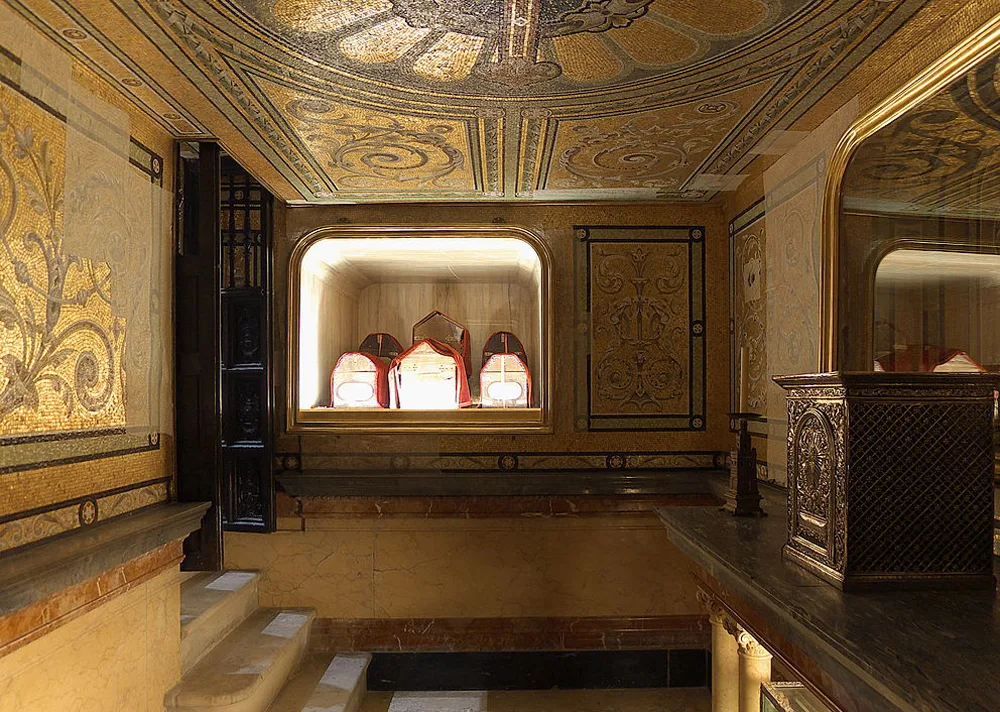
The Enriching Embrace of Seville Cathedral
In the final reflection of your Seville Cathedral visit, you carry with you an intricate mosaic of sensory and spiritual experiences. Each step through this Gothic masterpiece has been a step through history, art, and the collective soul of Seville. From the awe-inspiring heights of the Giralda Bell Tower to the hushed reverence of the Royal Chambers, your journey has been one of discovery and wonder.
A visit to Seville Cathedral is more than a mere tour; it is an enriching exploration of human creativity and devotion. As you emerge from its grand portals, you are not the same person who entered. You are now a custodian of its stories, a witness to its majesty, and a part of its continuing legacy.
So, embark on this journey, to explore and discover their own hidden treasures within the walls of Seville Cathedral. Each corner holds a whisper of the past, each altar shines with the devotion of centuries, and every carving and tapestry tells a story waiting to be heard.
Your Seville Cathedral visit awaits—full of potential for personal revelations and memories that will resonate long after you’ve returned to the rhythm of contemporary life. It is an experience that beckons with the promise of enchantment and leaves you with a profound sense of connection to the tapestry of human history.


